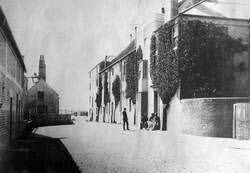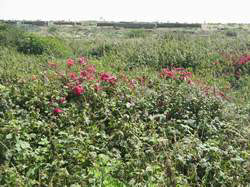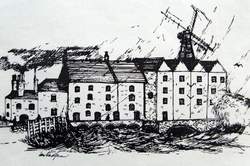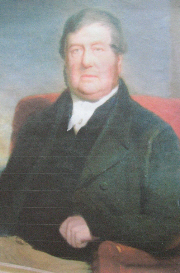Abandoned Communities ..... Tide Mills
During most of the first half of the nineteenth century the owner of Tide Mills was William Catt. Born in 1776 Catt entered the business in 1801 in partnership with his cousin Edmund Catt, but in 1808 he bought out Edmund. In the following years he added another mill pond on the west side of the mill. Water flowing from the additional pond into the main pond meant that the mill could be operated for longer at each tide. The number of mill stones was increased from five to sixteen pairs. A blacksmith's shop, a carpenter's shop, an office building, and a larger granary were built. Above the mill buildings a windmill was erected, apparently to supply power to the winches used to load flour into barges. When the wars with France ended Catt imported grain from France to supplement supplies bought from local farmers.
William Catt built houses for his staff, and in general took an interest in their welfare. At the same time he exercised authority over them, not just at work, but also when they were off duty. Tide Mills was surrounded by walls, and the three gates were locked each night at 10.10 pm. On one occasion Catt found two of his staff, having returned from an evening at the Buckle Inn, coming along the twitten towards the east gate at 10.20. Their privileges, including an allowance of beer and freedom to leave the village, were withdrawn for a month.
On festive occasions William Catt entertained staff at his home, Mill House. He would give a generous personal welcome to each guest. At one harvest dinner a guest is said to have approached Catt with the words “Give us yer hand, sir, I love ye; but I'm damned if I beant afear'd of ye though”.
Catt took great pleasure in developing the gardens of the village. Workers were encouraged to grow flowers and vegetables close to their homes. At some point an area in the middle of the village was used for greenhouses. Catt succeeded in growing a fig tree, and several pear trees climbed the walls of the mill buildings on the sheltered east side.
William Catt and his wife Hannah had eleven children. Hannah died at the age of 46 in 1823 a few hours after giving birth to their youngest son, Henry. Their oldest daughter, Elizabeth, then aged 26, took over the responsibility of caring for the younger children, and she continued to live with her father until his death in 1853.
The family vault, containing the remains of William and Hannah Catt, and their daughter Elizabeth, can be seen in the graveyard at Bishopstone church.
The mill continued to prosper for a decade or so after the death of William Catt, but then changing circumstances and a series of adverse events led to its decline and closure. In 1864 the railway was extended from Newhaven to Seaford by the London, Brighton and South Coast Railway. A station, Bishopstone Beach Halt, opened close to Tide Mills, and a spur from the mainline was created that ran along the main street through the village. Access to the railway network may have provided a temporary advantage to the mill, but farmers in the area soon realised that it was cheaper to send their grain to market by rail rather than have it milled locally.
Then a storm in 1875 severely harmed the working of the mill. In general the mill and the village were protected from the sea by a shingle bank, but during a high tide on 14 November 1875 the sea was carried over the shingle. It caused damage to buildings and dumped huge quantities of shingle in the two mill ponds.
In 1879 the mill was sold to the Newhaven Harbour Company, who carried out major development of the harbour at Newhaven. The outcome was that although water still flowed into the channel west of the mill ships were no longer able to enter it. The company closed the mill in 1883.
For a while the mill and granary found another use as a bonded warehouse. Between 1890 and 1900 they were leased for this purpose by the Café Royal of Regent Street, London. In 1901 the railway siding was taken up and the mill was demolished.
William Catt built houses for his staff, and in general took an interest in their welfare. At the same time he exercised authority over them, not just at work, but also when they were off duty. Tide Mills was surrounded by walls, and the three gates were locked each night at 10.10 pm. On one occasion Catt found two of his staff, having returned from an evening at the Buckle Inn, coming along the twitten towards the east gate at 10.20. Their privileges, including an allowance of beer and freedom to leave the village, were withdrawn for a month.
On festive occasions William Catt entertained staff at his home, Mill House. He would give a generous personal welcome to each guest. At one harvest dinner a guest is said to have approached Catt with the words “Give us yer hand, sir, I love ye; but I'm damned if I beant afear'd of ye though”.
Catt took great pleasure in developing the gardens of the village. Workers were encouraged to grow flowers and vegetables close to their homes. At some point an area in the middle of the village was used for greenhouses. Catt succeeded in growing a fig tree, and several pear trees climbed the walls of the mill buildings on the sheltered east side.
William Catt and his wife Hannah had eleven children. Hannah died at the age of 46 in 1823 a few hours after giving birth to their youngest son, Henry. Their oldest daughter, Elizabeth, then aged 26, took over the responsibility of caring for the younger children, and she continued to live with her father until his death in 1853.
The family vault, containing the remains of William and Hannah Catt, and their daughter Elizabeth, can be seen in the graveyard at Bishopstone church.
The mill continued to prosper for a decade or so after the death of William Catt, but then changing circumstances and a series of adverse events led to its decline and closure. In 1864 the railway was extended from Newhaven to Seaford by the London, Brighton and South Coast Railway. A station, Bishopstone Beach Halt, opened close to Tide Mills, and a spur from the mainline was created that ran along the main street through the village. Access to the railway network may have provided a temporary advantage to the mill, but farmers in the area soon realised that it was cheaper to send their grain to market by rail rather than have it milled locally.
Then a storm in 1875 severely harmed the working of the mill. In general the mill and the village were protected from the sea by a shingle bank, but during a high tide on 14 November 1875 the sea was carried over the shingle. It caused damage to buildings and dumped huge quantities of shingle in the two mill ponds.
In 1879 the mill was sold to the Newhaven Harbour Company, who carried out major development of the harbour at Newhaven. The outcome was that although water still flowed into the channel west of the mill ships were no longer able to enter it. The company closed the mill in 1883.
For a while the mill and granary found another use as a bonded warehouse. Between 1890 and 1900 they were leased for this purpose by the Café Royal of Regent Street, London. In 1901 the railway siding was taken up and the mill was demolished.
Two
Mill Drove, the main street through Tide Mills, from the north. Mill House, where William Catt and his family lived, is on the right. Pear trees cling to the walls of the buildings.
William Catt
Roses at Tide Mills in July 2011, presumably the descendants of plants that grew when the village was inhabited.
The remains of Chailey Heritage Hospital can be seen in the background.
Artist’s impression of a flood at Tide Mills in 1876, as seen from the tidal channel on the west side.



